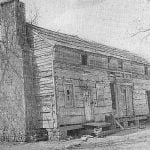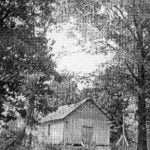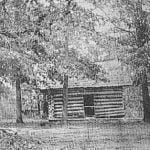As the preaching of the gospel and the organization of a Church preceded the establishment of the school, one should read about the founding and history of the Oak Hill Presbyterian Church first.
The Native Oak Hill School
The Negroes who were slaves of the Indians, about the year 1880 were enrolled and adopted as citizens, by the tribes to which they respectively belonged, and they then became entitled to a small part of their public school funds. The amount accorded the Choctaw Freedmen was about one dollar a year for a pupil that was enrolled as attending school. This made possible the employment of a teacher for a short term of three months in the vicinity of a few villages, where a large enrollment could be secured, but left unsupplied the greater number living in the sparsely settled neighborhoods.
Our Board of Missions for Freedmen, ever since its organization, has made it the duty of every negro minister commissioned by it, to maintain a school in their respective chapels several months each year, in order that the children of the community might have an opportunity to learn to read the Bible.
The first native teacher in the Oak Hill congregation was J. Ross Shoals, one of the elders of the Church, who had a large family and principally of boys. His work was that of a Bible reader or Sunday school teacher. About the year 1876 he began to hold meetings in the south arbor on Sabbath afternoons for the purpose of teaching both old and young to read the Bible with him. Nathan Mattison succeeded him the next year at the same place as a Sabbath school teacher.
In 1878, George M. Dallas, a carpenter, was employed to build a small frame school house on the southwest quarter of section 27, and after its completion he taught that year the first term of week day school among the colored people of that section. Others that succeeded Dallas, as teachers in this frame school house, were Mary Rounds, Henry Williams and Lee Bibbs.
Old Log House

In 1884, Henry Williams transferred the day school to the “old log house” on the northeast quarter of section 29, a mile and a half northwest of the school house. The motive for this change was the fact there was no supply of good water near the school house, while at the new location there was a good well and a large vacant building available for use.
Robin Clark, its owner and last occupant was an active member of the Oak Hill Church.
After occupying this building one or two years he moved to another one near Red river and generously tendered the free use of this one for the Oak Hill School. In 1885 Henry Friarson, another native teacher, taught the school in this same “old log house.”
All of these native teachers did the best they could, but deeply felt their insufficiency for the task laid on them, by the pressure of an urgent necessity. All had personal knowledge of the existence and unusual privileges afforded the children and youth of the Choctaws at Wheelock and Spencer Academies. It was also easy for them to see that as farmers they succeeded as well in securing good results from the cultivation of the soil as many of their Choctaw neighbors, and this fact tended to increase their desire to have a “fair chance” and equal share in the matter of educational privileges for their children.
The Oak Hill Church and school happened to be near the center of the widely scattered group of a half dozen Churches that formed the monthly circuit of Parson Charles W. Stewart. All who were interested in securing a good mission school approved this location as the most convenient for all of them, and, heartily uniting in an appeal for one, pledged their united support of it, when it should be established.
Appeal For Oak Hill
The appeal of the Choctaw Freedmen was presented to the Presbyterian Board of Missions for Freedmen by Rev. Alexander Reid and Rev. John Edwards, the missionaries in charge of the Indian work at Spencer Academy and Wheelock Academy, respectively.
In the early days many of the old Negroes were located near these educational institutions and they were sometimes sent by their masters to work for the missionaries. These men living in their midst had opportunity to witness their extreme poverty, utter ignorance and general degradation. They also heard their personal appeals for the light of knowledge and Bible truth. Their sympathetic interest was awakened and began to manifest itself towards them.

They were occasionally accorded the privilege of attending religious services, and at Doaksville, during the ministry of Rev. Cyrus Kingsbury, were permitted to hold occasional Sabbath afternoon meetings in the Choctaw Church. Primers, catechisms and testaments were sometimes presented to them and in this way a few of them learned to read the Bible. The kindly interest of these missionaries won their esteem and confidence and awakened in many of them an abiding love and affection for the Presbyterian Church.
It is related that when one of them was asked to unite with another Church because it was “more free” he replied, “You are too free for me, I need a stricter Church. I believe in staying by the old missionaries. They were our friends when we were slaves. They treated us well and did us good, and I mean to stay by their Church as long as I live.”
Slavery Among Indians
The state of religion among all of the people, both Indians and Negroes, was low, “very low”. One of the missionaries described that of the Negroes as being like that of the Samaritans. “They fear the Lord and serve their own gods. As their fathers did, so do they. Their condition is bad, morally and religiously.”

It could not easily have been otherwise. The tendency of slavery, under the most favorable conditions has always been in the direction of a low standard of morals and life. Slavery to untutored Indians, in a sparsely settled timber country, suggests the most deplorable condition imaginable. Such a slave lacking the example of intelligence and uprightness, often common among white masters, was subjected to generations of training in every phase of depravity and had no incentive whatever to live a better life.
When, however, these slaves of the Indians were accorded their freedom and became entitled to a part of the public school fund of the Choctaws, they manifested an earnest desire to have ministers and teachers sent them, that they might have Churches and schools of their own.
Their great need was a boarding school where the boys and girls especially those in the remote and neglected rural districts, could be taken from their homes and trained under the personal supervision of Christian teachers, to a higher standard of living, and, some at least, become fitted to serve as teachers of their own people.
